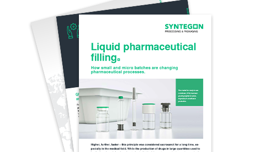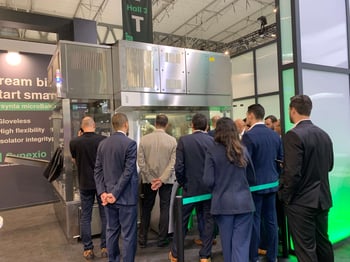What happens when two equal partners take on a new challenge? In the case of Vetter and Syntegon, the answer is “Versynta microBatch”. The fully automated, gloveless, Annex 1-compliant production cell underlines the pharmaceutical and technological innovative strength of both companies.

What happens when two equal partners take on a new challenge? In the case of Vetter and Syntegon, the answer is “Versynta microBatch”. The fully automated, gloveless, Annex 1-compliant production cell underlines the pharmaceutical and technological innovative strength of both companies.
As a leading Contract Development and Manufacturing Organization (CMDO), Vetter always focuses on the needs of its customers in the pharmaceutical and biotech industry. Looking to the future, the range of products is expanding – from large-volume production for high-demand indications to small batches of high-value medicines for individualized treatment of rare diseases.

A suitable partner as a critical success factor
This leads to an increasing need for small batch sizes, which in turn requires high flexibility and productivity. In addition, the loss of active ingredients must be minimized. Vetter recognized the need for a new solution that was not yet available on the market as early as 2019. Arno Schroff, Director Site and Plant Development at Vetter, and the interdisciplinary team paid particular attention to the requirements of Annex 1, which was being revised at the time.
“Especially from a regulatory point of view, the available equipment solutions did not sufficiently meet our high requirements. It became clear to us that we needed to create something completely new, together with a systems and machinery engineering partner,” Schroff explains. “We quickly decided on Syntegon, as we enjoy a good working relationship and have been working together on joint developments for many years. In fact, finding the right partner was one of the critical success factors for us.”
Get inspired with regular updates on technologies and services, case studies, webinar offers and events.


Versynta microBatch: the gloveless production cell
“The biggest challenge was to design the production cell based on isolator technology without glove ports,” explains Klaus Ullherr, Senior Product Manager at Syntegon. But the new Versynta microBatch solved this challenge successfully: The gloveless isolator with integrated air treatment significantly reduces the risk of contamination and eliminates the need for manual operator intervention. Thanks to the laminar flow optimized design, the air flows around the containers unhindered (“first air supply”).
Low-loss filling was another important aspect of the conceptual design, which is particularly important for customers with small, costly batches. Dies lässt sich mit Versynta microBatch dank 100% In-Prozess-Kontrolle (IPK) und kurzen Wegen für das Produkt umsetzen. The production cell fills and closes between 120 and 500 glass or polymeric containers such as vials, syringes, and cartridges per hour.

An award-winning development partnership
In October 2023, the time had finally come: Syntegon presented the prototype live at CPHI Barcelona – and announced the sale of the first Versynta microBatch to Vetter. The production cell had already gained recognition previously. The development partnership won the PDA Drug Delivery Award in the “Partnership Innovation” category in 2021, followed by the German Packaging Award for Syntegon just a year later.
“Ever smaller batch sizes are and will remain a trend. They will be needed in the future to advance not only orphan drugs and high-value products but also personalized medicine with even lower output,” says Schroff. “Versynta microBatch is a big step in the right direction; more will follow,” Ullherr adds. The development partners see themselves well prepared – and intend to continue to identify joint innovation potential.
Are you interested in Versynta microBatch or do you want to explore the benefits of a similar partnership? We look forward to hearing from you!
Downloads

Small and micro batch whitepaper
Learn how small and micro batches are changing pharmaceutical processes.




